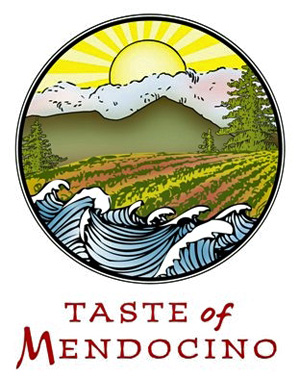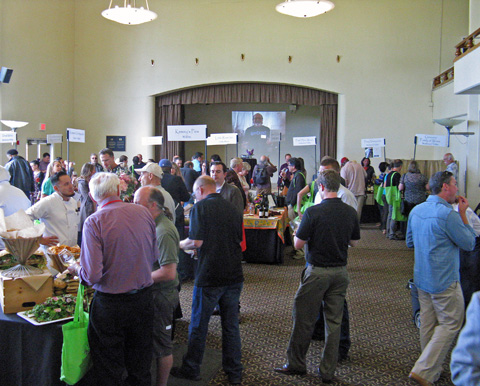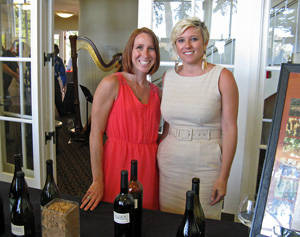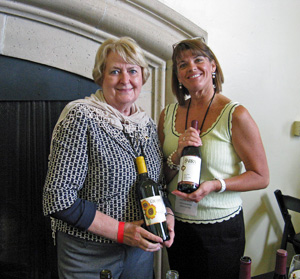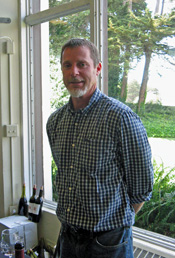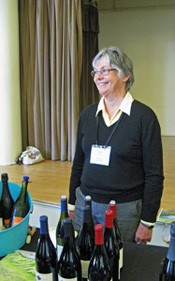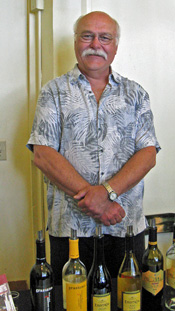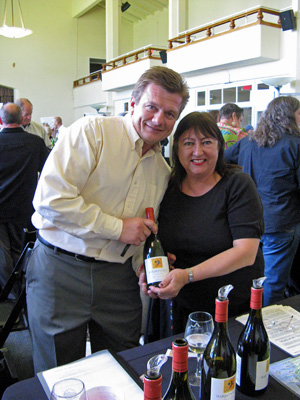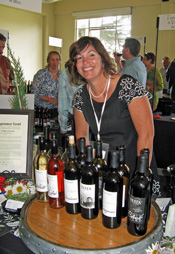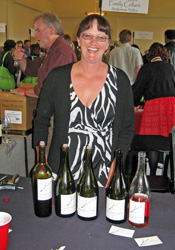Albertina Wine Cellars
Albertina 2009 Merlot, “Lorilai’s Reserve,” Zmarzly Family Vineyards, Mendocino County. 81% Merlot, 19% Cabernet Sauvignon. Medium-light purple color, with upfront vanilla/oak aromas plus black cherry and spice. Medium-bodied with a slightly rough tannic finish.
Albertina 2009 Cabernet Franc, “Meredith’s Reserve,” Zmarzly Family Vineyards, Mendocino County. 76% Cabernet Franc, 15% Petit Verdot, 9% Cabernet Sauvignon. Medium color, showing lots of fresh herbs on the nose along with plummy fruit, tobacco, and spice. Medium-full bodied with grippy tannins.
Albertina 2009 Cabernet Sauvignon, “Grand Reserve,” Zmarzly Family Vineyards, Mendocino County. 89% Cabernet Sauvignon, 6% Merlot, 4% Cabernet Franc, 1% Petit Verdot. Medium color, this featured plum and black cherry, smoky oak, dried herbs, and a touch of mocha. Richer texture, with firm but more refined tannins.
Albertina 2010 Cabernet Sauvignon, “Jocelyn’s Reserve,” Zmarzly Family Vineyards, Mendocino County. 100% Cabernet Sauvignon. Medium-dark purple, displaying a bigger tobacco/dried herb component along with a darker fruit profile and undertones of vanilla/oak. Medium-full bodied and structured, with a chewy tannic finish.
Comments: Fred and Alberta Zmarzly are the proprietors of Albertina, which specializes in wines made from Bordeaux grape varieties. Their vineyard is located in the hills west of Hopland. The 2009 wines were made by Penny Gadd-Coster, while Greg Graziano made the 2010 Cab.
Alder Springs Vineyard
Row Five 2011 Marsanne / Viognier, Alder Springs Vineyard, Mendocino County. 69% Marsanne, 31% Viognier. Medium-light straw color, this showed earth and stony minerals on the nose with lemon and fresh herbs in support. Medium-bodied with a lively mouthfeel and finish, nice.
Alder Springs 2010 Chardonnay, Alder Springs Vineyard, Mendocino County. 30% new oak. Light color, with apple and stone fruit, spice, and a touch of vanilla/oak. Medium-bodied with a moderately rich texture and smooth finish.
Alder Springs 2009 “13 Tasks,” Alder Springs Vineyard, Mendocino County. 44% Merlot, 37% Cabernet Sauvignon, 13% Cabernet Franc, 6% Petit Verdot. Medium purple color, displaying black cherry and plum, earth, tobacco, and stony mineral aromas. A leaner style with good structure and firm tannic finish, nice.
Alder Springs 2009 Syrah, Alder Springs Vineyard, Mendocino County. 100% Syrah. Medium color with floral notes along with black fruit, black pepper, and a savory component. Medium-bodied and lively on the palate with fairly grippy tannins – an intriguing young Syrah that should only improve with more bottle age.
Comments: Owned by Stuart Bewley, Alder Springs Vineyard is located in far northern Mendocino County, and has been a source of top-notch fruit for other wineries for many years. They recently began producing their own wines, and noted winemaker Byron Kosuge made the wines poured at the event. Row Five is a second label featuring more early-drinking bottlings. Natalie Holstine and Marsella Charron were behind the table at the tasting, and they poured a very impressive group of wines.
Barra of Mendocino Wines / Girasole Vineyards
Girasole 2011 Chardonnay, Mendocino County. Fermented in stainless steel, with some of the wine aged in oak. Very light color, this displayed ripe apple and pear aromas, plus lemonpeel, spice, and a hint of vanilla/oak in the background. Lighter-bodied with a bright mouthfeel and slightly creamy texture, and a crisp finish, nice.
Girasole 2012 Pinot Blanc, Mendocino County. Very light straw color, with intense pear and spice on the nose. Medium-bodied with a smoother texture and finish than the Chardonnay.
Barra 2012 Pinot Noir Rosé, Estate, Mendocino County. Very light pink color, featuring bright red fruits, along with mild herbal and floral notes. Medium-light weight on the palate with a slight tannic bite on the finish.
Girasole 2010 “Hybrid Red,” Mendocino County. Blend of Cabernet Sauvignon, Syrah, and Merlot. Medium-light color with dark berry and plum, spice, and a touch of sweet oak. Medium-bodied with a lively mouthfeel and mild tannins on the finish.
Barra 2009 Petite Sirah, Estate, Mendocino County. Medium-dark color, this was earthy and peppery, with black fruits and savory undertones. Medium-full bodied with a fairly rich texture and grippy tannins that sneaked up on the finish. A likeable Petite Sirah that should improve with some cellar time.
Comments: All of the fruit for these wines comes from the certified organic estate vineyard in Redwood Valley, first planted by Charlie Barra in the 1950s. Jason Welch is the winemaker for both the Barra and Girasole labels, while Martha Barra and Suzanne Negley poured the wines at the tasting. The Girasole “Hybrid Red” is a good value “pizza wine” and is bottled under screwcap.
Baxter Winery
Baxter 2011 Chardonnay, Oppenlander Vineyard, Mendocino County. Whole-cluster pressed and barrel-fermented in neutral oak. Light straw color, displaying pear and spice aromas, with hints of herbs and flowers. Medium-bodied with lively acidity and a clean finish, nice.
Baxter 2009 Syrah, Valenti Vineyard, Mendocino Ridge. Co-fermented with 6% Viognier. Medium color, this had lots of upfront blackberry fruit along with floral and herbal notes. Fairly big and structured, with chewy tannins that will need cellar time to soften.
Comments: I had tasted the Baxter Pinot Noirs recently so I tasted the two non-Pinots they were pouring, and I continue to be impressed by the this producer’s wines. Winemaker Phillip Baxter was on hand at the event. Wines undergo native yeast fermentation, and neutral oak is used for barrel-aging. The Baxter label was launched in 2002.
Bink Wines
Bink 2011 Sauvignon Blanc, Randle Hill Vineyard, Yorkville Highlands. From an organically-farmed vineyard, made entirely in stainless steel. Light straw color with citrus and herb aromas and a slight leesy note. Medium-light bodied with a clean finish.
Bink 2012 “Lumineux,” Hawk’s Butte Vineyard, Yorkville Highlands. Destemmed and left overnight before pressing, made entirely in stainless steel, with no malolactic fermentation. Light pink/salmon color, featuring fairly shy red fruit aromas along with a touch of fresh herbs. Medium weight on the palate with w round mouthfeel and smooth finish.
Bink 2008 Pinot Noir, Weir Vineyard, Yorkville Highlands. Medium ruby color, this wine showed the unfortunate effects of the 2008 vintage. I couldn’t get past the smoky aromas and even more intense smoky finish on this wine to think about any of its other attributes.
Bink 2009 Merlot, Hawk’s Butte Vineyard, Yorkville Highlands. Medium purple color, displaying black cherry, plum, and spice on the nose. Medium-bodied with good structure and moderate tannins.
Bink 2006 Syrah, Hawk’s Butte Vineyard, Yorkville Highlands. 25% whole-cluster fermentation, about 30% new oak. Medium-dark purple, with dark berry fruits, herbs, and a slight iron/mineral note. Big and structured, with a fairly grippy tannic finish.
Bink 2009 Cabernet Sauvignon, Old Chatham Ranch, Yorkville Highlands. Medium-dark color, this showed plum and currant fruit, tobacco/dried herb, white pepper and earth, and a touch of sweet oak. Fairly rich texture with firm but refined tannins, nice.
Comments: Bink was founded in 2003 by Cindy Paulson and winemaker Deb Schatzlein, who was on hand to pour her wines. Bink owns noted Hawks Butte Vineyard at about 1,200-foot elevation in the Yorkville Highlands just southeast of Anderson Valley, where they grow Syrah and Merlot.
Claudia Springs Winery
Claudia Springs 2012 Pinot Gris, Klindt Vineyard, Anderson Valley. Made entirely in stainless steel, bottled under screwcap. Very light straw color, featuring very floral aromas plus pear fruit and a touch of fresh herbs. Medium-light bodied with juicy acidity in the mouth and a chalky texture on the finish, nice.
Claudia Springs 2010 Carignane, Vittorio Vineyard, Redwood Valley. Medium purple color, with plum and wild berry fruit, earth, herbs, and a touch of black pepper. Medium weight with a bright mouthfeel and moderate tannins.
Claudia Springs 2010 Grenache, Rhodes Vineyard, Redwood Valley. Medium-light color, this showed red fruits, herbs, and a spicy note. Medium-bodied with fairly grippy tannins.
Claudia Springs NV “Blend 5,” Redwood Valley. Medium color, with black cherry and berry, earth, and undertones of earth and oak. Medium-bodied with moderate tannins.
Claudia Springs 2010 “Vittorio’s Secret,” Vittorio Vineyard, Redwood Valley. Field blend of mostly Zinfandel, and also includes Carignan, Petite Sirah, Barbera, Grenache, and Alicante Bouschet. Medium-dark color, displaying bright and brambly wild berry and darker fruit, dried herbs, spice, and pepper. Moderately rich texture and structured on the palate, finishing with big but fine tannins, nice.
Comments: Although Bob and Claudia Klindt’s winery and estate vineyard is located in the “Deep End” of Anderson Valley near Navarro, many of the Claudia Springs wines come from grapes grown in warmer Redwood Valley. Both Bob and Claudia were behind the table at the tasting, and they poured a very nice group of wines.
Demuth Kemos Wines
Demuth Kemos 2011 Chardonnay, Demuth Vineyard, Anderson Valley. From 25+ year old Wente clone vines, fermented in 50% stainless steel and 50% oak, mostly neutral. Light color, with bright citrus and green apple, spice, and a chalky mineral note. Medium-bodied with a creamy texture but vibrant acidity and a clean finish, nice.
Demuth Kemos 2011 Chardonnay, Demuth Vineyard, Anderson Valley (all stainless steel). From a small bottling made entirely in stainless steel. This displayed more upfront and pure fruit than the previous wine, along with more zippy acidity in the mouth and on the finish, quite distinct from the regular bottling.
Demuth Kemos 2011 Pinot Noir, “Laguna de Santa Rosa,” Russian River Valley. 20% whole-cluster fermentation, no new oak. Light ruby color, this had savory/herbal aromas along with red fruits, earth, and spice. Medium-light bodied, with a lively texture and moderate tannins.
Demuth Kemos 2011, Syrah, Bei Ranch, Sonoma Coast. From a cool-climate site at 1,600-foot elevation to the west of Cazadero, 100% whole-cluster fermentation, 85 days on the skins, aged in ten-year old barrels. Medium purple color, showing very floral aromas along with smoked meat, herbs, and dark fruits. Medium-bodied with bright acidity and firm tannins – a young Syrah that shows lots of potential.
Demuth Kemos 2009 Cabernet Sauvignon, Bei Ranch, Sonoma Coast. 30% whole-cluster fermentation, barrel-aged entirely in neutral oak. Medium-dark color, with currant and plum fruit, tobacco/dried herbs, and a stony mineral note. Big and structured with a rich but lively texture and long finish with grippy tannins, another promising wine that needs more age.
Comments: Demuth Kemos was founded in 2004 by Eric Demuth and Peter Kemos, and the winery has focused on Chardonnay, Syrah, and Cabernet Sauvignon. Eric and his father planted Demuth Vineyard high in the hills above Boonville in 1982. Eric poured some very good wines but I only included the Chardonnay on my list of favorites since the others came from outside Mendocino County.
Drew Wines
Drew 2012 Albariño, Anderson Valley. Sourced from Valenti and Wentzel vineyards, made in 80% stainless steel and 20% neutral oak, with 100% malolactic fermentation. Light straw color, displaying apple and citrus fruit, lees, and a stony mineral component. Medium-light bodied with bright acidity and a clean finish, nice.
Drew 2011 Pinot Noir, Weir Vineyard, Yorkville Highlands. 50% whole-cluster fermentation, 25% new oak. Light ruby color, this showed forest floor and mushroom notes upfront, along with herbs, cherry fruit, and an iron/mineral note. Medium-bodied with fairly mild tannins, distinctive and very nice.
Drew 2011 Syrah, Perli Vineyard, Mendocino Ridge. 40% whole-cluster fermentation plus another 15% added stems, co-fermented with 3% Viognier, aged in three-year old oak. Medium purple color, with black fruits, a notable stemmy/spicy element, plus smoke and fennel on the nose. Medium-full bodied and very lively, with moderately chewy tannins. This has lots of potential but needs time in the cellar.
Drew 2011 Syrah, Valenti Vineyard, Mendocino Ridge. 100% whole-cluster fermentation, co-fermented with 3% Viognier, aged in three-year old oak. Medium color, with slightly floral black fruits, spice and earth, an herbal/savory component, and an iron/mineral note. Big and structured, with a grippy tannic finish – distinctive and tasty now and should improve with more bottle age.
Comments: Jason Drew poured his wines, and they were one of the strongest line-ups I tasted at the event. I had tasted the Drew Pinots from Anderson Valley recently, so I skipped those. Jason and Molly Drew have planted their own vineyard with Pinot Noir – they’re located only about three miles from the ocean in the Mendocino Ridge AVA.
Edmeades Winery
Edmeades 2010 Zinfandel, Mendocino County. 88% Zinfandel and 11% each Syrah and Petite Sirah, 20% new oak. Medium purple color, with ripe berry fruit along with lots of upfront vanilla/oak. Medium-bodied and fairly smooth, with milder tannins.
Edmeades 2009 Zinfandel, Shamrock Vineyard, Mendocino County. 100% Zinfandel from a newer 2,800-foot elevation vineyard near the Humboldt border, aged in 54% new oak. Medium color, this displayed black cherry and raspberry, with earth, spice, and sweet oak. A bit more full-bodied than the first wine, with lively acidity and a grippy tannic finish.
Edmeades 2010 Zinfandel, Piffero Vineyard, Redwood Valley. 100% Zinfandel from 70+ year old vines. Medium color, featuring brighter wild berry and darker berry fruit, black pepper, dried herbs, and undertones of spice and oak. Rich but vibrant on the palate, with firm tannins and a long, tasty finish, nice.
Comments: Dr. Donald Edmeades planted the first post-Prohibition commercial vineyard in Anderson Valley in 1963, and the Edmeades label was launched in 1972. Long-known for its Zinfandels, the winery has been owned by Jackson Family Wines since 1988.
Elke Vineyards
Mary Elke 2011 Pinot Gris, Donnelly Creek Vineyard, Anderson Valley. Whole-cluster pressed, made in stainless steel and older oak. Very light color, displaying pear, spice, and earth on the nose. Medium-light bodied and vibrant on the palate, with a stony mineral feel, and a long, crisp finish, nice.
Mary Elke 2011 Chardonnay, Anderson Valley. Fermented in stainless steel and aged in oak for ten months. Light yellow color, with ripe apple, spice, and a touch of vanilla/oak. Medium-bodied with a round mouthfeel combined with a lively acidity and finish.
Mary Elke 2011 Pinot Noir, “Boonville Barter,” Anderson Valley. Very light Rosé-like color, this showed earthy red fruits, herbs, and smoky oak notes. Medium-light weight on the palate with fairly mild tannins, a good value for an early-drinking 2011 Anderson Valley Pinot.
Comments: Mary Elke was on hand to pour her wines. I had tasted a number of her Anderson Valley Pinots recently, so I passed on those at this event. Much of her fruit is sourced from the estate Donnelly Creek Vineyard just west of Boonville, planted in the mid-1990s. As usual, Mary poured a solid group of wines.
Graziano Family of Wines
Monte Volpe 2011 Pinot Grigio, Mendocino County. Very light color, this featured peach and tropical fruit and a touch of spice on the nose. Medium-bodied with a bright mouthfeel and finish.
Enotria 2011 Arneis, Mendocino County. Light straw color, with apple and pear aromas along with a leesy note. Medium weight in the mouth with good acidity and a slightly chalky finish.
Graziano 2011 Chenin Blanc, Mendocino County. From 50+ year old vines. Light color, showing apple, orangepeel, and a slight stony, minerally component. Richer on the palate but with good balancing acidity and a long finish, crisp and refreshing.
Monte Volpe 2010 Aglianico, Mendocino County. Medium purple color, plum and blueberry, earth, and iron/mineral aromas. Medium-bodied with a fairly lively mouthfeel, finishing with moderate tannins, quite distinctive.
Enotria 2009 Dolcetto, Mendocino County. Slightly darker color, with dark berry fruit, earth, and lots of spice on the nose. More full-bodied, with a big, chewy tannic finish.
Graziano 2010 Zinfandel, Kazmet Vineyard, “Old Vine,” Redwood Valley. From 50+ year old head-pruned, dry-farmed vines, aged in 20% new oak. Medium color, this showed bright boysenberry, smoke, earth, spice, with touches of black pepper and sweet oak. Medium-full bodied and structured, finishing with big but refined tannins, nice.
Comments: The Graziano line-up of wines includes the Enotria, Monte Volpe, Saint Gregory, and Graziano labels. The white wines are all aged on the lees in older oak, and do not go through malolactic fermentation. Bob Meadows poured the wines at the event – he recently retired after many years as the tasting room manager but continues to work with vintner Greg Graziano. This was a good line-up of wines.
|
Handley Cellars
Handley 2011 Chardonnay, Estate, Anderson Valley. Made in 30% stainless steel and 70% French oak (21% new). Light color, with earthy and herbal citrus aromas plus lots of spice. Medium-light weight with bright acidity and a clean finish.
Handley 2011 Chardonnay, Whispering Oaks Vineyard, Mendocino County. From an organic vineyard in the Ukiah Valley, made in 41% stainless steel and 59% French oak (20% new). Slightly lighter straw color, this displayed leesy pear and apple fruit and a touch of vanilla/oak. Medium-rich texture with a chalky quality and fairly smooth finish.
Handley 2012 Pinot Gris, Anderson Valley. Made in 34% stainless steel and 66% neutral oak. Very light straw color, ripe apple and stone fruit with undertones of flowers and spice on the nose. Medium-light bodied with a lively mouthfeel and finish.
Handley 2012 Gewürztraminer, Anderson Valley. Made in stainless steel and neutral oak, 0.3% residual sugar. Light straw color, with intense lychee and citrus aromas along with touches of flowers and spice. Bright mouthfeel with a moderately rich texture and clean finish, nice.
Handley 2010 Pinot Noir, Mendocino County. Sourced from vineyards in Potter Valley, Anderson Valley, and Mendocino Ridge. Medium-light ruby color, this displayed upfront ripe cherry fruit, plus undertones of spice and sweet oak. Medium-bodied with a fairly smooth texture and fairly mild tannins.
Comments: Founded in 1982 by winemaker Milla Handley, the estate vineyard near Navarro has been certified organic since 2005. Pinot Noir, Chardonnay, and Gewürztraminer are planted there. The aromatic white wines are bottled under screwcap. Their 2010 “Reserve” Pinot, which I had tasted recently, is quite good.
Harmonique Wine
Harmonique 2008 Chardonnay, “Un-Oaked,” Anderson Valley. Sourced from Corby Vineyard. Medium-light straw color, this had slightly higher-toned apple and pear aromas along with a stony mineral note. Medium-bodied with lively acidity and a smooth finish.
Harmonique 2007 Pinot Noir, “The Noble One,” Anderson Valley. From Klindt and Wiley vineyards, with Pommard, 115, and 777 clones. Medium-light garnet color, featuring earthy red fruits, tea leaf, spice, and undertones of vanilla/oak. Medium-light weight on the palate with a fairly bright texture and finish.
Harmonique 2007 Pinot Noir, “Elegancé,” Anderson Valley. Sourced from Klindt, Conzelman, Wiley, and Ferrington vineyards. Medium-light color, with brighter red fruit aromas plus forest floor, earth, and baking spice notes. Medium-bodied with good structure and fine tannins, nice.
Comments: A partnership between Bruce Conzelman and Claudia Springs’ Bob Klindt, Harmonique specializes in Chardonnay and Pinot Noir. Pinots are held back for release longer than at most wineries. I had tasted their 2007 “Delicacé” Pinot at another recent event so I didn’t re-taste it, and the “Elegancé” Pinot was my favorite of their three from that vintage. Moira Conzelman was behind the table at the event.
Husch Vineyards
Husch 2012 Sauvignon Blanc, Mendocino County. Made in stainless steel. Very light straw color, this displayed bright grapefruit and a touch of stone fruit, with a lightly grassy herbal quality. Medium-light bodied with juicy acidity and a clean, crisp finish, nice.
Husch 2012 Gewürztraminer, Anderson Valley. Made in stainless steel, 0.6% residual sugar. Very light straw color, showing citrus aromas with spice and floral notes in the background. Medium-light weight in the mouth, a hint of sweetness came through on the finish.
Husch 2010 Cabernet Sauvignon, Mendocino County. Aged in 25% new French and American oak. Medium purple color, black cherry and plum fruit, baking spice, and touches of mocha and vanilla/oak on the nose. Medium-light bodied with a fairly smooth texture and moderate tannins.
Husch 2011 Late Harvest Gewürztraminer, Anderson Valley. Picked at 35 brix with botrytis on the fruit, 14.1% residual sugar. Medium-light gold color, with intense apricot and spice aromas, along with honey and orangepeel notes. Bright acidity in the mouth kept the sweetness in check, and the finish was long and smooth, nice.
Comments: Located between Philo and Navarro, Husch is the oldest winery in Anderson Valley – it was established by Tony and Gretchen Husch in 1971. The winery has been owned by the Oswald family since 1979. The current proprietors, Zac Robinson and Amanda Robinson Holstine, are the third generation of the Oswald family at Husch, and Brad Holstine is the winemaker. I skipped their Pinot Noir since I had tried it recently.
Jeriko Estate
Jeriko 2012 Chardonnay, “Upper Russian River,” Estate, Mendocino County. Light straw color, with lots of vanilla/oak aromas plus pear and ripe apple fruit and spice. Medium-bodied with a lively texture and a slight stony mineral quality on the finish.
Jeriko 2011 Pinot Noir, “Dijon Clone,” Estate, Mendocino County. Medium-light ruby color, showing ripe strawberry and cherry, earth, and undertones of spice and sweet oak. Medium weight on the palate with a moderately tannic finish.
Jeriko 2010 Sangiovese, Estate, Mendocino County. Medium purple color, with ripe cherry and vanilla aromas, dried herbs, and touches of earth and spice. Bright acidity and a lively mouthfeel, finishing with somewhat chewy tannins.
Jeriko 2009 Syrah, “Reserve,” Estate, Mendocino County. Medium-dark color, this was earthy and herbal, with black fruits and sweet oak in support. A bit thin on the palate, with a grippy tannic finish.
Comments: Jeriko was founded in 1997 by Daniel Fetzer, and the estate vineyard near Hopland was planted with Chardonnay, Pinot Noir, and Sangiovese the same year. The vineyard is farmed biodynamically and is Demeter-certified. The Sangiovese was my favorite of the four wines.
Lula Cellars
Lula 2012 Rosato, Mendocino County. Made from Pinot Noir from the estate vineyard in Comptche, made entirely in stainless steel. Light pink/salmon color, with red fruits, spice, and a hint of flowers. Bright mouthfeel with a clean finish.
Lula 2012 Gewürztraminer, Mendocino County. Made in stainless steel, aged on the lees. Very light straw color, displaying aromas of lychee and citrus fruit, flowers, earth, and herbs. Medium-light weight on the palate with juicy acidity and a dry, crisp finish, nice.
Lula 2010 Pinot Noir, Mendocino County. From Pommard, 115, and 777 clones from the Comptche vineyard, aged in 40% new French oak. Medium color, this had strawberry and cherry, spice, and a touch of vanilla oak on the nose. Medium-bodied with good structure and moderate tannins.
Comments: Lula is the project of veteran Mendocino winemaker Jeff Hansen. He owns a 15-year old vineyard in Comptche, a few miles north of Anderson Valley, and more recently bought property in the Philo area. I had tasted Lula’s Anderson Valley Pinot recently, and the winery has a solid line-up across the board.
Masút Vineyard and Winery
Masút 2011 Pinot Noir, Estate, Mendocino County. From 113, 115, and 777 clones, aged in 35% new oak. Medium-light color, with black cherry and plum, spice, and vanilla/oak aromas. Medium-bodied with a lively texture, moderate tannins, and a slight stony/mineral component on the finish. Shows promise although it needs time in the cellar for all the parts to integrate more.
Comments: A venture launched in 2009 by third-generation vintner brothers Jake and Ben Fetzer, Masút is located in Redwood Valley. Their 23-acre hillside vineyard was planted by the family in 1997. There is petition to create a new Eagle Peak AVA in the area that includes the vineyard site. The 2011 Pinot shows that this may be a winery worth watching.
Meyer Family Cellars
Meyer 2011 Chardonnay, Donnelly Creek Vineyard, Anderson Valley. Made in 33% new French oak. Very light color, this had apple, earth, spice, and vanilla/oak aromas. Lively yet creamy on the palate, this had a firm finish.
Meyer 2012 Dry Rosé of Syrah, Summerwood Vineyard, Yorkville Highlands. Whole-cluster pressed and made entirely in neutral oak. Light pink/salmon color, featuring watermelon, spice, and hints of citrus and fresh herbs. Medium-light bodied with a fairly lively texture and finish.
Meyer 2009 Syrah, Yorkville Highlands. 92% Syrah, 8% Petite Sirah, all destemmed fruit, aged in about 25% new oak. Medium-dark color, this showed upfront black fruits, chocolate, spice, and sweet oak on the nose. Medium-bodied and structured in the mouth, with chalky tannins on the finish.
Meyer 2009 Syrah, “High Ground,” Yorkville Highlands. Barrel selection, 50% new oak. Medium-dark color, with more herbal and red fruit character than the previous wine, along with spice and a bigger vanilla/oak element. Bigger, richer mouthfeel with a grippier tannic finish.
Comments: Established in 1987 by Silver Oak founders Justin and Bonny Meyer, the label is now run by their son Matt and his wife Karen, although Bonny remains actively involved as well. In addition to Napa Valley Cab (including a bottling from famed Bonny’s Vineyard), Meyer Family produces a number of Mendocino County wines, including Anderson Valley Chardonnay as well as Syrah, Petite Sirah, and a Zinfandel Port from a number of vineyards in the Yorkville Highlands.
Navarro Vineyards
Navarro 2012 Gewürztraminer, Anderson Valley. 0.35% residual sugar. Very light straw color, this had intense aromas of citrus and lychee, along with notes of flowers and spice. Medium-light bodied with a vibrant mouthfeel and a clean, fresh finish, nice.
Navarro 2012 Rosé, Mendocino County. From 92% Grenache, 8% Carignan, whole-cluster pressed. Very light pink, with bright strawberry and raspberry on the nose along with touches of herbs and pepper. Medium-light bodied and lively, with a crisp finish.
Navarro 2010 Chardonnay, “Première Reserve,” Anderson Valley. Full malolactic fermentation, made in 33% new oak. Light straw color, displaying apple and pear fruit, lees, and undertones of earth and vanilla/oak. Medium weight on the palate with a lively texture and finish.
Comments: One of the earlier modern Anderson Valley wineries, Navarro was founded by Ted Bennett and Deborah Cahn. In 1974, they began planting their estate vineyard near Philo with Gewürztraminer, Pinot Noir, Riesling, Muscat, and Chardonnay. Winemaker Jim Klein has been at Navarro since 1992. I had tasted Navarro’s current Pinot Noir Rosé and several vintages of “Méthode à l'Ancienne” Pinots recently, and they continue to produce solid wines across the board.
Philo Ridge Vineyards
Philo Ridge 2011 Pinot Gris, Klindt Vineyard, Anderson Valley. Made in stainless steel. Light straw color, this had fresh citrus and stone fruit aromas with a touch of herbs. Lighter-bodied with a fairly smooth mouthfeel and finish.
Philo Ridge 2012 Gewürztraminer, Ferrington Vineyard, Anderson Valley. Light color, with shy lychee and stone fruit, plus lots of spice on the nose. Medium-light weight in the mouth with a livelier texture than the Pinot Gris plus a smooth finish.
Philo Ridge 2010 Viognier, Nelson Ranch, Mendocino County. A little residual sugar. Light straw color, with ripe stone fruit and tropical fruit notes with floral undertones. Medium-light bodied with a touch of sweetness on the finish.
Philo Ridge NV “Vino di Mendocino II,” Mendocino County. 50% Zinfandel, 30% Syrah, 20% Petite Sirah, from four vineyards in the Hopland and Ukiah areas, aged in neutral oak. Medium purple color, featuring red berry fruit, black pepper, and baking spices. Medium-bodied and lively on the palate, with milder tannins, an attractive “pizza wine.”
Philo Ridge 2009 Zinfandel, Mendocino County. Sourced from Redwood Valley, 90% Zinfandel, 5% Syrah, 5% Petite Sirah. Medium color, this showed ripe wild berry and plum, a touch of pepper, and a good deal of vanilla/oak. Medium weight with a fairly rich texture and fine tannins.
Philo Ridge 2009 “Coro Mendocino,” Mendocino County. 50% Zinfandel, 20% Syrah, 15% Petite Sirah, 15% Carignane. Medium-dark purple color, this had slightly floral aromas plus black fruits, earth, and lots of spice. Big and structured in the mouth, with a chewy tannic finish.
Comments: Philo Ridge proprietors Fred Buonanno and Heather McKelvey purchased the vineyard and winery site of the old Christine Woods Winery in 1999, and Norman Kobler directed new plantings there in 2000. Heather is the winemaker, and the first Philo Ridge wines were released in 2004. The winery is entirely powered by solar and wind energy. I liked their 2009 Anderson Valley Pinot, which I had tasted recently.
Seebass Vineyards & Family Wines
Seebass 2011 Chardonnay, “Grand Reserve,” Estate, Mendocino County. From a small block of the vineyard, whole-cluster pressed. Light yellow/straw color, with pear, tropical fruit, and vanilla/oak scents. Moderately rich and creamy mouthfeel, with a smooth finish.
Seebass 2011 Syrah, “Reserve,” Estate, Mendocino County. Medium purple color, this displayed dark berry fruit, spice, earth, and sweet oak. Medium-bodied and structured, with a fairly grippy tannic finish.
Comments: Seebass has been growing winegrapes for over 25 years but only recently began producing its own wines. The vineyard is located just east of Ukiah, and is planted toChardonnay, Grenache, Merlot, Syrah, and Zinfandel, including some Zin vines that are over a century old.
Testa Vineyards
Testa 2010 “White,” Mendocino County. Mostly Sauvignon Blanc, plus Viogner, Muscat Canelli, Pinot Gris and Chenin Blanc. Light straw color, featuring ripe citrus and stone fruit aromas along with distinct floral and herbal notes. Medium weight on the palate with a smooth texture and finish, a pleasant summertime wine.
Testa 2010 Charbono Mendocino County. From 60 year old vines. Medium purple color, this showed an earthy and herbal character, plus blackberry fruit and a dash of sweet oak. Medium-bodied with milder tannins.
Testa 2010 Zinfandel, “Old Vine,” Mendocino County. Medium color, with riper berry fruit, touches of spice and pepper, and a bigger vanilla/oak component. Medium-light bodied, with moderate tannins on the finish.
Testa 2010 Carignane, Mendocino County. Medium-dark color, boysenberry and plum fruit, earth, and dried herbs on the nose. Medium weight with bigger structure and brighter acidity, and a clean and moderately grippy finish, nice.
Testa 2010 “Black – Tre,” Mendocino County. Mostly Cabernet Sauvignon, plus Carignane and Petite Sirah. Dark purple color, this displayed tobacco/dried herbs, earth, and dark fruits. Medium-full bodied with a richer mouthfeel and moderate but firm tannins on the finish – this still needs some time to settle down but should be a pleasant red blend.
Comments: Maria Testa Martinson poured her wines at the event – her great-grandparents Gaetano and Maria Testa first planted their family’s vineyard in Calpella near Redwood Valley in 1912. It’s planted to Carignane, Petite Sirah, Zinfandel, Barbera, Grenache, and Charbono. Although the family has farmed winegrapes for over a century, they only began making their own commercial wines a few years ago.
Waits-Mast Family Cellars
Waits-Mast 2012 Rosé of Pinot Noir, Mendocino County. Made by saignée method, sourced from Deer Meadows, Mariah, and Nash Mill Vineyards. Light salmon color, with red fruits, spice and a floral note. Medium-light bodied with a fairly smooth mouthfeel and finish.
Waits-Mast 2010 Pinot Noir, Oppenlander Vineyard, Mendocino County. From 114 clone, entirely destemmed, aged in 25% new oak. Medium-light ruby color, this featured forest floor, dried herb, raspberry and plum aromas. Medium-full bodied, with bright acidity, moderately grippy tannins, and a long clean finish, nice.
Comments: Jennifer Waits & Brian Mast established their winery in 2005, and they focus solely on Pinot Noir, mostly sourced from Anderson Valley and nearby Oppenlander Vineyard in Comptche. The wines are made in San Francisco, and grapes are fermented with native yeasts. I had tasted the Waits-Mast Anderson Valley Pinots recently, and they were very good. Both Jennifer and Brian were on hand at the event.
Witching Stick Wines
Witching Stick 2010 Zinfandel Rosato, Fashauer Vineyard, Anderson Valley. Made by saignée, aged in neutral oak. Medium-light pink color, displaying ripe red fruits and spice on the nose. On the bigger side for Rosé but with a lively mouthfeel and finish.
Witching Stick 2011 Chardonnay, Durell Vineyard, Sonoma Valley. Whole-cluster pressed and fermented in 50% new French oak. Medium-light yellow-straw color, this had ripe stone fruit, lees, lots of spice, and vanilla/oak. Rich and creamy on the palate, with a long, smooth finish.
Witching Stick 2011 Pinot Noir, Gianoli Vineyard, Mendocino Ridge. About 25% whole-cluster fermentation and aged in about 70% new oak. Light ruby color, with herbal red fruit aromas, plus mushroom and spice notes and undertones of well-integrated oak. Medium-bodied and structured, with firm tannins on the finish – quite tasty now and should improve with time in the cellar.
Witching Stick 2010 Zinfandel, Fashauer Vineyard, Anderson Valley. Medium purple color, this featured earthy plum and blueberry fruit, dried herbs, baking spice, and vanilla/oak. Medium weight on the palate with lively acidity and moderate tannins, nice.
Comments: Witching Stick is the project of longtime Edmeades winemaker Van Williamson and partner Anne Fashauer, who was behind the table at the event. The first wines released from this new label were from the 2010 vintage. I had tasted their Cerise Vineyard Pinot from Anderson Valley in May, and it was a standout. The estate Fashauer Vineyard is in the cooler end of Anderson Valley and was planted in 2000 with budwood sourced from century-old Dupratt Vineyard a short distance away.
|


